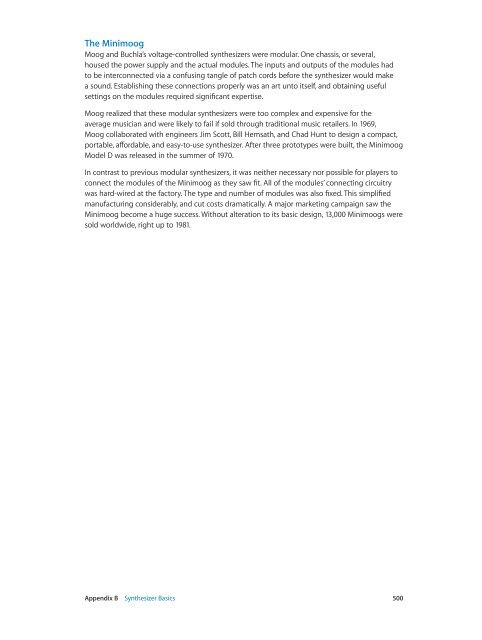Apple MainStage 3 Instruments - MainStage 3 Instruments
Apple MainStage 3 Instruments - MainStage 3 Instruments
Apple MainStage 3 Instruments - MainStage 3 Instruments
You also want an ePaper? Increase the reach of your titles
YUMPU automatically turns print PDFs into web optimized ePapers that Google loves.
The Minimoog<br />
Moog and Buchla’s voltage-controlled synthesizers were modular. One chassis, or several,<br />
housed the power supply and the actual modules. The inputs and outputs of the modules had<br />
to be interconnected via a confusing tangle of patch cords before the synthesizer would make<br />
a sound. Establishing these connections properly was an art unto itself, and obtaining useful<br />
settings on the modules required significant expertise.<br />
Moog realized that these modular synthesizers were too complex and expensive for the<br />
average musician and were likely to fail if sold through traditional music retailers. In 1969,<br />
Moog collaborated with engineers Jim Scott, Bill Hemsath, and Chad Hunt to design a compact,<br />
portable, affordable, and easy-to-use synthesizer. After three prototypes were built, the Minimoog<br />
Model D was released in the summer of 1970.<br />
In contrast to previous modular synthesizers, it was neither necessary nor possible for players to<br />
connect the modules of the Minimoog as they saw fit. All of the modules’ connecting circuitry<br />
was hard-wired at the factory. The type and number of modules was also fixed. This simplified<br />
manufacturing considerably, and cut costs dramatically. A major marketing campaign saw the<br />
Minimoog become a huge success. Without alteration to its basic design, 13,000 Minimoogs were<br />
sold worldwide, right up to 1981.<br />
Appendix B Synthesizer Basics 500
















